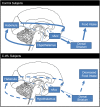The habenula as a novel link between the homeostatic and hedonic pathways in cancer-associated weight loss: a pilot study
- PMID: 29575771
- PMCID: PMC5989751
- DOI: 10.1002/jcsm.12286
The habenula as a novel link between the homeostatic and hedonic pathways in cancer-associated weight loss: a pilot study
Abstract
Background: Little is known about the brain mechanisms underlying cancer-associated weight loss (C-WL) in humans despite this condition negatively affecting their quality of life and survival. We tested the hypothesis that patients with C-WL have abnormal connectivity in homeostatic and hedonic brain pathways together with altered brain activity during food reward.
Methods: In 12 patients with cancer and 12 healthy controls, resting-state functional connectivity (RSFC, resting brain activity observed through changes in blood flow in the brain which creates a blood oxygen level-dependent signal that can be measured using functional magnetic resonance imaging) was used to compare three brain regions hypothesized to play a role in C-WL: the hypothalamus (homeostatic), the nucleus accumbens (hedonic), and the habenula (an important regulator of reward). In addition, the brain reward response to juice was studied. Participants included 12 patients with histological diagnosis of incurable cancer (solid tumours), a European Cooperative Oncology Group performance status of 0-2, and a ≥5% involuntary body weight loss from pre-illness over the previous 6 months and 12 non-cancer controls matched for age, sex, and race. RSFC between the hypothalamus, nucleus accumbens, and habenula and brain striatum activity as measured by functional MRI during juice reward delivery events were the main outcome measures.
Results: After adjusting for BMI and compared with matched controls, patients with C-WL were found to have reduced RSFC between the habenula and hypothalamus (P = 0.04) and between the habenula and nucleus accumbens (P = 0.014). Patients with C-WL also had reduced juice reward responses in the striatum compared with controls.
Conclusions: In patients with C-WL, reduced connectivity between both homeostatic and hedonic brain regions and the habenula and reduced juice reward were observed. Further research is needed to establish the relevance of the habenula and striatum in C-WL.
Trial registration: ClinicalTrials.gov NCT01614990.
Keywords: Cancer anorexia; Cancer cachexia; Habenula; Hypothalamus; Nucleus accumbens; Resting-state functional connectivity.
Published 2018. This article is a U.S. Government work and is in the public domain in the USA. Journal of Cachexia, Sarcopenia and Muscle published by John Wiley & Sons Ltd on behalf of the Society on Sarcopenia, Cachexia and Wasting Disorders.
Figures




Similar articles
-
Altered resting-state functional connectivity and effective connectivity of the habenula in irritable bowel syndrome: A cross-sectional and machine learning study.Hum Brain Mapp. 2020 Sep;41(13):3655-3666. doi: 10.1002/hbm.25038. Epub 2020 Jun 3. Hum Brain Mapp. 2020. PMID: 32488929 Free PMC article.
-
Investigating Habenula Functional Connectivity and Reward-Related Activity in Obesity Using Human Connectome Project Data.Brain Connect. 2023 Nov;13(9):541-552. doi: 10.1089/brain.2023.0034. Epub 2023 Sep 21. Brain Connect. 2023. PMID: 37578129
-
Role of habenula and amygdala dysfunction in Parkinson disease patients with punding.Neurology. 2017 Jun 6;88(23):2207-2215. doi: 10.1212/WNL.0000000000004012. Epub 2017 May 10. Neurology. 2017. PMID: 28490656
-
Resting-state functional connectivity of the human hypothalamus.Handb Clin Neurol. 2021;179:113-124. doi: 10.1016/B978-0-12-819975-6.00005-4. Handb Clin Neurol. 2021. PMID: 34225957 Review.
-
Anhedonia in depression symptomatology: Appetite dysregulation and defective brain reward processing.Behav Brain Res. 2019 Oct 17;372:112041. doi: 10.1016/j.bbr.2019.112041. Epub 2019 Jun 17. Behav Brain Res. 2019. PMID: 31220485 Review.
Cited by
-
Habenular connectivity predict weight loss and negative emotional-related eating behavior after laparoscopic sleeve gastrectomy.Cereb Cortex. 2023 Feb 20;33(5):2037-2047. doi: 10.1093/cercor/bhac191. Cereb Cortex. 2023. PMID: 35580853 Free PMC article.
-
Neural Mechanisms of Cancer Cachexia.Cancers (Basel). 2021 Aug 7;13(16):3990. doi: 10.3390/cancers13163990. Cancers (Basel). 2021. PMID: 34439145 Free PMC article. Review.
-
Editorial: The Habenula and Its Role in Neuropsychiatric Symptoms.Front Behav Neurosci. 2022 May 24;16:929507. doi: 10.3389/fnbeh.2022.929507. eCollection 2022. Front Behav Neurosci. 2022. PMID: 35685273 Free PMC article. No abstract available.
-
Altered habenula to locus coeruleus functional connectivity in past anorexia nervosa suggests correlation with suicidality: a pilot study.Eat Weight Disord. 2020 Oct;25(5):1475-1480. doi: 10.1007/s40519-019-00746-0. Epub 2019 Aug 2. Eat Weight Disord. 2020. PMID: 31376112 Free PMC article.
-
Circulating myeloid cells invade the central nervous system to mediate cachexia during pancreatic cancer.Elife. 2020 May 11;9:e54095. doi: 10.7554/eLife.54095. Elife. 2020. PMID: 32391790 Free PMC article.
References
-
- Evans WJ, Morley JE, Argiles J, Bales C, Baracos V, Guttridge D, et al. Cachexia: a new definition. Clin Nutr 2008;27:793–799. - PubMed
-
- Dewys WD, Begg C, Lavin PT, Band PR, Bennett JM, Bertino JR, et al. Prognostic effect of weight loss prior to chemotherapy in cancer patients. Eastern Cooperative Oncology Group. Am J Med 1980;69:491–497. - PubMed
-
- Adamopoulos S, Parissis JT, Georgiadis M, Karatzas D, Paraskevaidis J, Kroupis C, et al. Growth hormone administration reduces circulating proinflammatory cytokines and soluble Fas/soluble Fas ligand system in patients with chronic heart failure secondary to idiopathic dilated cardiomyopathy. Am Heart J 2002;144:359–364. - PubMed
-
- Lasheen W, Walsh D. The cancer anorexia‐cachexia syndrome: myth or reality? Support Care Cancer 2010;18:265–272. - PubMed
-
- Tisdale MJ. Mechanisms of cancer cachexia. Physiol Rev 2009;89:381–410. - PubMed
Publication types
MeSH terms
Associated data
Grants and funding
LinkOut - more resources
Full Text Sources
Other Literature Sources
Medical

